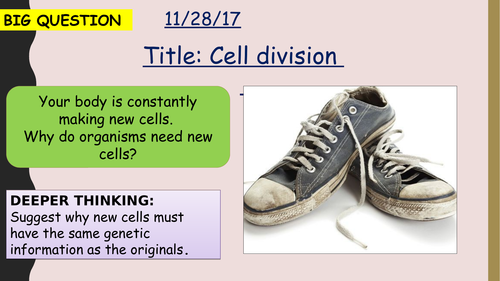

Cell division (mitosis) lesson created in accordance to the NEW AQA Specification (9-1). Designed for a higher ability separates class, although content can be adjusted to suit any ability. Includes: slide animations, practice questions with answers on slides and worksheet.
AQA spec link: 4.1.2.1 & 4.1.2.2
Relevant chapter: B2 Cell division. AQA Biology third edition textbook-Page 26-27
Specification requires students to know the following;
The nucleus of a cell contains chromosomes made of DNA molecules. Each chromosome carries a large number of genes. In body cells the chromosomes are normally found in pairs.
Cells divide in a series of stages called the cell cycle. Students should be able to describe the stages of the cell cycle, including mitosis. During the cell cycle the genetic material is doubled and then divided
into two identical cells. Before a cell can divide it needs to grow and increase the number of
sub-cellular structures such as ribosomes and mitochondria. The DNA replicates to form two copies of each chromosome.
In mitosis one set of chromosomes is pulled to each end of the cell and the nucleus divides.
Finally the cytoplasm and cell membranes divide to form two identical cells.
Students need to understand the three overall stages of the cell cycle but do not need to know the different phases of the mitosis stage.
Cell division by mitosis is important in the growth and development of multi-cellular organisms.
Students should be able to recognise and describe situations in given contexts where mitosis is occurring.
AQA spec link: 4.1.2.1 & 4.1.2.2
Relevant chapter: B2 Cell division. AQA Biology third edition textbook-Page 26-27
Specification requires students to know the following;
The nucleus of a cell contains chromosomes made of DNA molecules. Each chromosome carries a large number of genes. In body cells the chromosomes are normally found in pairs.
Cells divide in a series of stages called the cell cycle. Students should be able to describe the stages of the cell cycle, including mitosis. During the cell cycle the genetic material is doubled and then divided
into two identical cells. Before a cell can divide it needs to grow and increase the number of
sub-cellular structures such as ribosomes and mitochondria. The DNA replicates to form two copies of each chromosome.
In mitosis one set of chromosomes is pulled to each end of the cell and the nucleus divides.
Finally the cytoplasm and cell membranes divide to form two identical cells.
Students need to understand the three overall stages of the cell cycle but do not need to know the different phases of the mitosis stage.
Cell division by mitosis is important in the growth and development of multi-cellular organisms.
Students should be able to recognise and describe situations in given contexts where mitosis is occurring.
Get this resource as part of a bundle and save up to 25%
A bundle is a package of resources grouped together to teach a particular topic, or a series of lessons, in one place.
Something went wrong, please try again later.
Report this resourceto let us know if it violates our terms and conditions.
Our customer service team will review your report and will be in touch.
£3.00
